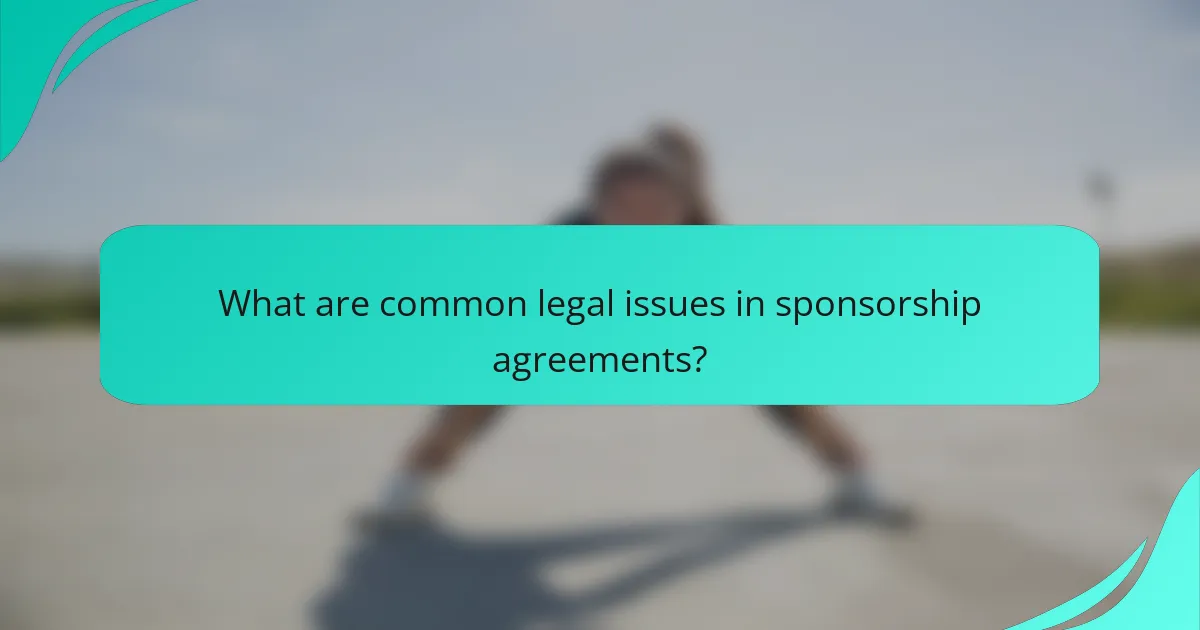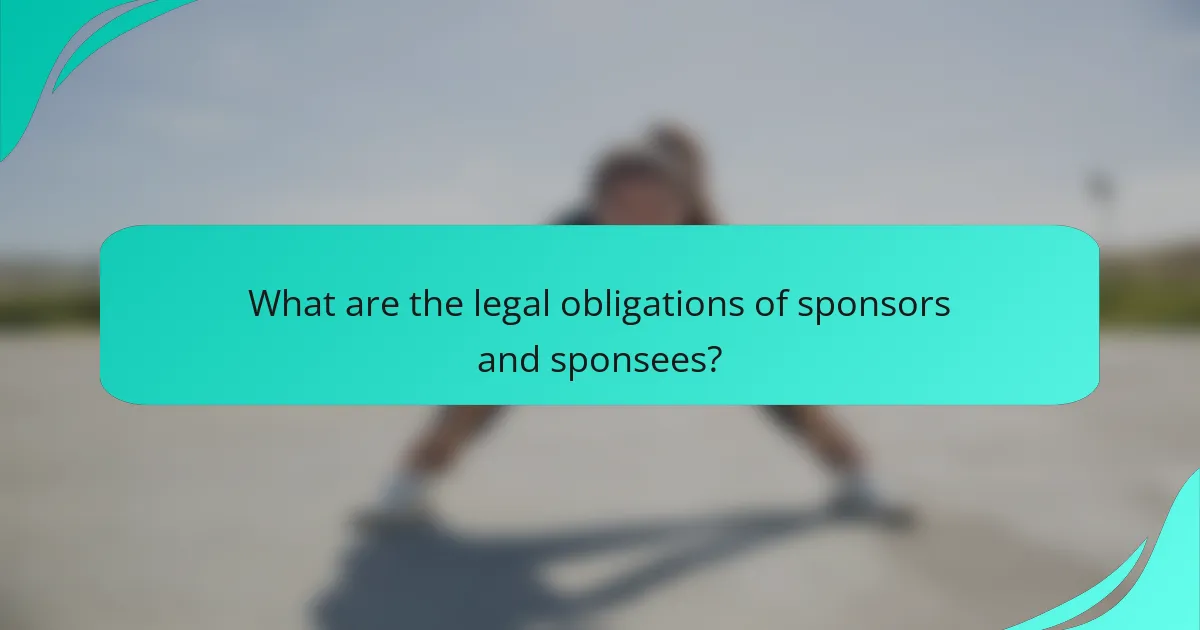Understanding the legal aspects of sponsorship agreements is vital for both sponsors and sponsored parties to establish a clear and mutually beneficial relationship. These agreements typically encompass key components such as the parties involved, financial terms, and intellectual property rights, all of which must be carefully negotiated. Additionally, awareness of potential legal issues, including compliance risks and dispute resolution mechanisms, is essential for ensuring a successful partnership.

What are the key components of a sponsorship agreement?
A sponsorship agreement typically includes several essential components that outline the relationship between the sponsor and the sponsored party. Key elements include the parties involved, the scope of sponsorship, duration and termination clauses, financial terms, and intellectual property rights.
Parties involved
The parties involved in a sponsorship agreement are usually the sponsor, who provides financial or in-kind support, and the sponsored entity, which may be an individual, organization, or event. It is crucial to clearly identify each party’s legal name and contact information to avoid any confusion.
Additionally, if there are any third parties, such as agents or representatives, their roles should also be defined. This ensures that all stakeholders understand their responsibilities and obligations under the agreement.
Scope of sponsorship
The scope of sponsorship outlines the specific activities or events that the sponsor will support. This may include branding opportunities, promotional activities, or exclusive rights to certain events. Clearly defining this scope helps prevent misunderstandings about what is included in the sponsorship.
For example, a sponsor may want to be the exclusive beverage provider at a sporting event, while also receiving advertising space on promotional materials. Both parties should agree on the extent of these rights to ensure mutual benefit.
Duration and termination
The duration of a sponsorship agreement specifies how long the sponsorship will last, which can range from a single event to multiple years. It is essential to include start and end dates to provide clarity on the commitment involved.
Termination clauses should also be included to outline the conditions under which either party can end the agreement early. Common reasons for termination include breach of contract or failure to meet agreed-upon obligations.
Financial terms
Financial terms detail the monetary aspects of the sponsorship, including the total amount to be paid, payment schedules, and any additional costs that may arise. This section should be clear to avoid disputes over financial obligations.
For instance, a sponsor might agree to pay a fixed fee upfront, with additional payments based on performance metrics or sales generated through the sponsorship. Including these details helps both parties understand their financial commitments.
Intellectual property rights
Intellectual property rights in a sponsorship agreement address the use of logos, trademarks, and other proprietary materials. It is crucial to specify who owns these rights and how they can be used by the sponsor and the sponsored party.
For example, the sponsor may want to use the sponsored entity’s logo in marketing materials, while the sponsored entity may seek to use the sponsor’s branding in promotional efforts. Clearly defining these rights helps protect both parties’ interests and prevents potential legal issues.

How to negotiate a sponsorship agreement effectively?
Effective negotiation of a sponsorship agreement involves understanding both parties’ needs and finding common ground. Focus on clear communication and mutual benefits to create a successful partnership.
Identify mutual benefits
Identifying mutual benefits is crucial for a successful sponsorship agreement. Both parties should outline what they hope to gain, such as brand exposure for the sponsor and financial support or resources for the sponsee.
Consider creating a list of potential benefits, such as increased visibility, access to new audiences, or enhanced credibility. This helps in aligning goals and expectations, making negotiations smoother.
Set clear objectives
Setting clear objectives is essential for guiding the negotiation process. Define specific goals for the sponsorship, such as target audience reach, branding milestones, or sales targets.
Establishing measurable objectives allows both parties to evaluate the success of the partnership. Use metrics like engagement rates or sales growth to track progress and adjust strategies as needed.
Use legal counsel
Engaging legal counsel during the negotiation of a sponsorship agreement can prevent misunderstandings and protect both parties’ interests. A lawyer can help draft terms that are clear and enforceable, reducing the risk of disputes.
Ensure that your legal advisor is familiar with sponsorship laws and regulations in your country, as these can vary significantly. This expertise can help navigate complex issues such as liability, intellectual property, and compliance with advertising standards.

What are common legal issues in sponsorship agreements?
Common legal issues in sponsorship agreements include non-compliance risks, dispute resolution mechanisms, and liability clauses. Understanding these aspects is crucial for both sponsors and sponsored parties to ensure a smooth partnership and mitigate potential conflicts.
Non-compliance risks
Non-compliance risks arise when either party fails to adhere to the terms outlined in the sponsorship agreement. This can lead to financial penalties, loss of sponsorship rights, or even legal action. It is essential for both parties to clearly understand their obligations, including deliverables, timelines, and performance metrics.
To minimize non-compliance risks, sponsors should establish clear communication channels and regular check-ins with the sponsored entity. Drafting detailed agreements that outline specific responsibilities can also help prevent misunderstandings and disputes.
Dispute resolution
Dispute resolution refers to the methods used to resolve conflicts that may arise during the sponsorship period. Common approaches include negotiation, mediation, and arbitration. Including a clear dispute resolution clause in the agreement can save time and resources by providing a structured process for addressing issues.
Parties should consider specifying the preferred method of resolution and the governing law in the contract. This ensures that both parties are aware of the steps to take in case of a disagreement, which can help maintain a positive working relationship.
Liability clauses
Liability clauses outline the responsibilities and potential liabilities of each party in the event of a breach or other legal issues. These clauses are crucial for protecting both the sponsor and the sponsored entity from unforeseen circumstances. It is important to clearly define the extent of liability and any limitations that may apply.
When drafting liability clauses, parties should consider including indemnification provisions, which require one party to compensate the other for certain damages. Additionally, setting caps on liability can help manage risk and provide clarity on potential financial exposure in case of disputes.

What are the legal obligations of sponsors and sponsees?
Sponsors and sponsees have specific legal obligations that govern their relationship, primarily focused on compliance with laws, disclosure of information, and performance metrics. Understanding these obligations is crucial to avoid legal pitfalls and ensure a successful partnership.
Compliance with advertising laws
Both sponsors and sponsees must adhere to advertising laws that regulate promotional activities. This includes ensuring that advertisements are truthful, not misleading, and comply with local regulations, such as the Federal Trade Commission (FTC) guidelines in the United States.
For instance, if a sponsor promotes a product through a sponsee, they must ensure that any claims made about the product are substantiated. Failure to comply can result in fines or legal action.
Disclosure requirements
Disclosure requirements mandate that sponsors and sponsees clearly communicate their relationship to the audience. This often involves stating that a post or promotion is sponsored, which helps maintain transparency and trust with consumers.
In many jurisdictions, including the EU and the US, failing to disclose sponsorship can lead to penalties. A simple way to meet this requirement is to use clear language such as “Paid partnership” or “Sponsored by” in promotional content.
Performance metrics
Performance metrics are essential for evaluating the success of sponsorship agreements. Sponsors typically expect measurable outcomes, such as increased brand awareness or sales, which should be defined in the agreement.
Common metrics include engagement rates, conversion rates, and return on investment (ROI). Both parties should agree on these metrics upfront to ensure that expectations are aligned and to facilitate effective reporting and analysis throughout the partnership.

How do sponsorship agreements vary by industry?
Sponsorship agreements differ significantly across industries, influenced by the nature of the business, target audience, and marketing objectives. Understanding these variations is crucial for both sponsors and sponsored entities to maximize benefits and ensure compliance.
Sports sponsorships
Sports sponsorships are among the most visible and lucrative forms of sponsorship agreements. They often involve partnerships with teams, leagues, or events, where brands gain exposure through logos on uniforms, signage, and media coverage. The financial commitments can range from thousands to millions of dollars, depending on the sport’s popularity and the event’s scale.
When entering a sports sponsorship, consider the audience demographics and engagement levels. For example, a local team may offer lower costs but also a smaller reach, while a major league team can provide extensive visibility. Ensure that the agreement outlines deliverables, such as media rights and promotional activities, to avoid misunderstandings.
Entertainment sponsorships
Entertainment sponsorships encompass a wide range of activities, including concerts, film festivals, and television shows. These agreements typically focus on brand integration into the entertainment experience, such as product placements or event sponsorships. Budgets can vary widely, often from a few thousand dollars for local events to several million for high-profile productions.
Key considerations in entertainment sponsorships include audience alignment and creative execution. Brands should assess how their values resonate with the entertainment content and ensure that their involvement feels authentic. Clear terms regarding promotional rights and obligations are essential to protect both parties’ interests and maximize the partnership’s impact.
